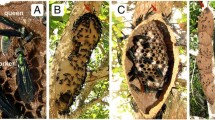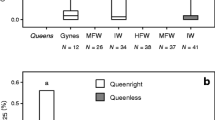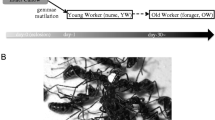Abstract
In colonies of the queenless ant Streblognathus peetersi, dominance interactions produce a reproductive hierarchy in which one individual, the alpha, is capable of producing offspring while her subordinates remain infertile. Based on differences between behaviour and cuticular hydrocarbon profiles, the subordinates can be further divided into high and low ranking workers. Although it had been shown previously that alphas treated with a juvenile hormone analog lose their reproductive status, little was known of the endocrinological basis of dominance in this species. To elucidate the underlying endocrinology of these three ranks, we measured the individual in vitro rate of juvenile hormone (JH) production of excised corpora allata, and the ecdysteroid titer of pooled hemolymph samples. Production of JH was highest in low-ranking workers, intermediate in high rankers, and almost undetectable in alphas. Ecdysteroid titers were low for low rankers, but were more than twice as high for both high rankers and alphas. The results support the hypothesis that JH suppresses ovarian function in these queenless ants, and suggest that ecdysteroids may be responsible for stimulating vitellogenin production. The possible role of these hormones as behavioural modulators is also discussed.

Similar content being viewed by others
References
Bloch G, Wheeler DE, Robinson GE (2002) Endocrine influences on the organization of insect societies. In: Pfaff DW, Arnold AP, Ettgen AM, Fahrbach SE, Rubin RT (eds) hormones, brain, and behavior, vol 3. Academic Press, San Diego, CA, pp 195–237
Blomquist GJ, Jurenka R, Schal C, Tittiger C (2005) Biochemistry and molecular biology of pheromone production. In: Gilbert LI, Iatrou K, Gill SS (eds) Comprehensive molecular insect science, vol 3. Elsevier, Boston, pp 705–751
Brent CS, Vargo EL (2003) Changes in juvenile hormone in maturing virgin queens of Solenopsis invicta. J Insect Physiol 49:967–974
Cuvillier-Hot V, Lenoir A, Crewe R, Malosse C, Peeters C (2004a) Fertility signaling and reproductive skew in queenless ants. An Behav 68:1209–1219
Cuvillier-Hot V, Lenoir A, Peeters C (2004b) Reproductive monopoly enforced by sterile police workers in a queenless ant. Behav Ecol 15:970–975
Cuvillier-Hot V, Renault V, Peeters C (2005) Rapid modification in the olfactory signal of ants following a change in reproductive status. Naturwissenschaften 92:73–77
Elekonich MM, Robinson GE (2000) Organizational and activational effects of hormones on insect behavior. J Insect Physiol 46:1509–1515
Fahrbach SE (1997) Regulation of age polyethism in bees and wasps by juvenile hormone. Adv Study Behav 26:285–315
Feyereisen R, Tobe SS (1981) A rapid partition assay for routine analysis of juvenile hormone release by insect corpora allata. Anal Biochem 111:372–375
Goodman WG, Granger NA (2005) The juvenile hormones. In: Gilbert LI, Iatrou K, Gill SS (eds) Comprehensive molecular insect science, vol 3. Elsevier, Boston, pp 320–408
Harano K, Sasaki K, Nagao T (2005) Depression of brain dopamine and its metabolite after mating in European honeybee (Apis mellifera) queens. Naturwissenschaften 92:310–313
Hartfelder K, Emlen DJ (2005) Endocrine control of insect polyphenism. In: Gilbert LI, Iatrou K, Gill SS (eds) Comprehensive molecular insect science, vol 3. Elsevier, Boston, pp 651–703
Hartfelder K, Engels W (1998) Social insect polymorphism: hormonal regulation of plasticity in development and reproduction in the honeybee. Curr Topics Dev Biol 40:45–77
Holbrook GL, Chiang AS, Schal C (1997) Improved conditions for culture of biosynthetically active cockroach corpora allata. In Vitro Cell Dev Biol 33A:452–458
Lafont R, Dauphin-Villemant C, Warren JT, Rees H (2005) Ecdysteroid chemistry and Biochemistry. In: Gilbert LI, Iatrou K, Gill SS (eds) Comprehensive molecular insect science, vol 3. Elsevier, Boston, pp 125–195
Monnin T, Peeters C (1999) Dominance hierarchy and reproductive conflicts among subordinates in a monogynous queenless ant. Behav Ecol 10:323–332
Nijhout HF, Wheeler DE (1982) Juvenile hormone and the physiological basis of polymorphisms. Quart Rev Biol 57:109–133
Nijhout HF (1994) Insect hormones. Princeton University Press, Princeton, NJ
Peeters C (1993) Monogyny and polygyny in ponerine ants with or without queens. In: Keller L (ed) Queen number and sociality in insects. Oxford University Press, Oxford, pp 234–261
Pratt GE, Tobe SS (1974) Juvenile hormone radiobiosynthesised by corpora allata of adult female locusts in vitro. Life Sci 14:575–586
Raikhel AS, Brown MR, Belles X (2005) Hormonal control of reproductive processes. In: Gilbert LI, Iatrou K, Gill SS (eds) Comprehensive molecular insect science, vol 3. Elsevier, Boston, pp 433–491
Robertson HG (2002) Revision of the ant genus Streblognathus (Hymenoptera: Formicidae: Ponerinae). Zootaxa 97:1–16
Robinson GE, Vargo EL (1997) Juvenile hormone in the social hymenoptera: gonadotropin and behavioral pacemaker. Arch Insect Biochem Physiol 35:559–583
Sommer K, Hölldobler B, Rembold H (1993) Behavioral and physiological aspects of reproductive control in the Diacamma species from Malaysia (Formicidae, Ponerinae). Ethology 94:162–170
Swever BL, Raikhel AS, Sappington TW, Shirk P, Iatrou K (2005) Vitellogenesis and post-vitellogenic maturation of the insect ovarian follicle. In: Gilbert LI, Iatrou K, Gill SS (eds) Comprehensive molecular insect science, vol 1. Elsevier, Boston, pp 87–155
Tobe SS, Pratt GE (1974) The influence of substrate concentrations on the rate of insect juvenile hormone biosynthesis by corpora-allata of the desert locust in vitro. Biochem J 144:107–113
Vargo EL, Laurel M (1994) Studies on the mode of action of a queen primer pheromone of the fire ant Solenopsis invicta. J Insect Physiol 40:601–610
Warren JT, Gilbert LI (1986) Ecdysone metabolism and distribution during the pupal-adult development of Manduca sexta. Insect Biochem 16:65–82
Warren JT, Smith W, Gilbert L (1984) Simplification of the ecdysteroid radioimmunoassay by the use of Protein A from staphylococcus aureus. Experientia 40:393–394
West-Eberhard MJ (1996) Wasp societies as microcosms for the study of development and evolution. In: Turillazzi S, West-Eberhard MJ (eds) Natural history an evolution of paper wasps. Oxford University Press, New York, pp 290–317
Zera AJ, Bottsford J (2001) The endocrine-genetic basis of life-history variation: the specific relationship between the ecdysteroid titer and morph-specific reproduction in the wing-polymorphic cricket Gryllus firmus. Evolution 55:538–549
Acknowledgments
We would like to thank the Department of Water Affairs and Forestry (Limpopo Province) for collecting permits. This work was partially supported by a grant from the National Research Foundation of South Africa. We thank Drs. L. Gilbert and J. Warren, University of North Carolina—Chapel Hill, for supplying ecdysteroid antibody, and Dr. C. Schal, Department of Entomology, North Carolina State University, for assistance with radiochemical analysis. All experiments were conducted in accordance the “Principles of animal care”, publication No. 86-23, revised 1985 of the National Institute of Health, and with current United States statutes governing research.
Author information
Authors and Affiliations
Corresponding author
Additional information
An erratum to this article can be found at http://dx.doi.org/10.1007/s00359-006-0107-8
Rights and permissions
About this article
Cite this article
Brent, C., Peeters, C., Dietmann, V. et al. Hormonal correlates of reproductive status in the queenless ponerine ant, Streblognathus peetersi . J Comp Physiol A 192, 315–320 (2006). https://doi.org/10.1007/s00359-005-0065-6
Received:
Revised:
Accepted:
Published:
Issue Date:
DOI: https://doi.org/10.1007/s00359-005-0065-6




